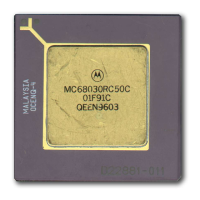Signal Description
5-4
MC68030 USER’S MANUAL
MOTOROLA
5.2 FUNCTION CODE SIGNALS (FC0
–
FC2)
These three-state outputs identify the address space of the current bus cycle. Table 4-1
shows the relationship of the function code signals to the privilege levels and the address
spaces. Refer to
4.2 Address Space Types
for more information.
5.3 ADDRESS BUS (A0
–
A31)
These three-state outputs provide the address for the current bus cycle, except in the CPU
address space. Refer to
4.2 Address Space Types
for more information on the CPU
address space. A31 is the most significant address signal. Refer to
7.1.2 Address Bus
for
information on the address bus and its relationship to bus operation.
5.4 DATA BUS (D0
–
D31)
These three-state bidirectional signals provide the general-purpose data path between the
MC68030 and all other devices. The data bus can transfer 8, 16, 24, or 32 bits of data per
bus cycle. D31 is the most significant bit of the data bus. Refer to
7.1.4 Data Bus
for more
information on the data bus and its relationship to bus operation.
5.5 TRANSFER SIZE SIGNALS (SIZ0, SIZ1)
These three-state outputs indicate the number of bytes remaining to be transferred for the
current bus cycle. With A0, A1, DSACK0, DSACK1, and STERM, SIZ0 and SIZ1 define the
number of bits transferred on the data bus. Refer to
7.2.1 Dynamic Bus Sizing
for more
information on the size signals and their use in dynamic bus sizing.

